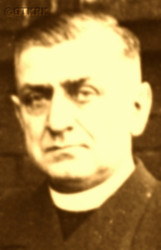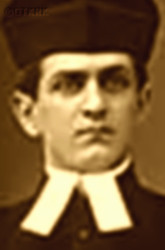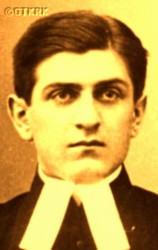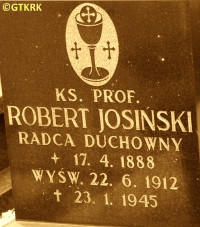Roman Catholic
St Sigismund parish
05-507 Słomczyn
85 Wiślana Str.
Konstancin deanery
Warsaw archdiocese, Poland
full list:
displayClick to display full list

searchClick to search full list by categories
wyświetlKliknij by wyświetlić pełną listę po polsku

szukajKliknij by przeszukać listę wg kategorii po polsku

Martyrology of the clergy — Poland
XX century (1914 – 1989)
personal data
surname
JOSIŃSKI
forename(s)
Robert
function
diocesan priest
creed
Latin (Roman Catholic) Church RCmore on
en.wikipedia.org
[access: 2014.09.21]
diocese / province
Katowice diocesemore on
en.wikipedia.org
[access: 2013.05.19]
Apostolic Administration of Upper Silesiamore on
www.catholic-hierarchy.org
[access: 2021.12.19]
Wrocław diocesemore on
en.wikipedia.org
[access: 2013.05.19]
academic distinctions
Sacred Theology MA
honorary titles
Ad Honores Spiritual Counselor
(1931)
„Pro Ecclesia et Pontifice”more on
en.wikipedia.org
[access: 2019.02.02]
(1929)
Silver „Cross of Merit”more on
en.wikipedia.org
[access: 2019.04.16]
(1936)
„For Long Service” medal — bronzemore on
en.wikipedia.org
[access: 2020.05.25]
(1938)
date and place
of death
23.01.1945

Chorzówform.: Królewska Huta (till 1934)
today: Chorzów city pov., Silesia voiv., Poland
more on
en.wikipedia.org
[access: 2010.08.11]
details of death
In 1921‐1922, after the end of the World War I and rebirth of independent Poland, involved in Polish efforts to win plebiscite, mandated by the Versaille treaty of 06.1919 ending the World War I, that was to decide the on the national affiliation of Upper Silesia.
After the plebiscite on 20.03.1921 and division of Upper Silesia moved to the part that was granted to Poland.
During World War II started in 09.1939 by German and Russian invasion of Poland, after start of German occupation, ministered in Chorzów, incorporated directly by German occupiers into Germany, initially into Germ. Provinz Schlesien (Eng. Silesia Province),and from 1941 into Germ. Provinz Oberschlesien (Eng. Upper Silesia Province).
There perished — from tuberculosis — 4 days before Germans leaving the town and arrival of the Russian forces (the Russians captured Chorzów on 28.01.1945, during the so‐called Vistula–Oder Operation, which was part of the larger Russian winter offensive of 1945, ending the military conflict of the World War II in Europe).
cause of death
disease
sites and events
Ribbentrop‐MolotovClick to display the description, Pius XI's encyclicalsClick to display the description, Silesian UprisingsClick to display the description
date and place
of birth
17.04.1888

Bralintoday: Bralin gm., Kępno pov., Greater Poland voiv., Poland
more on
en.wikipedia.org
[access: 2021.07.18]
parents
JOSIŃSKI Anthony
🞲 ?, ? — 🕆 ?, ?

GOGOL Francesca
🞲 ?, ? — 🕆 ?, ?
presbyter (holy orders)
ordination
22.06.1912

Wrocławtoday: Wrocław city pov., Lower Silesia voiv., Poland
more on
en.wikipedia.org
[access: 2021.04.02]
positions held
1939 – 1945
vicar — Chorzówform.: Królewska Huta (till 1934)
today: Chorzów city pov., Silesia voiv., Poland
more on
en.wikipedia.org
[access: 2010.08.11] ⋄ St Barbara RC parish ⋄ Chorzówform.: Królewska Huta (till 1934)
today: Chorzów city pov., Silesia voiv., Poland
more on
en.wikipedia.org
[access: 2010.08.11] RC deanery
1939
vicar — Mikołówtoday: Mikołów urban gm., Mikołów pov., Silesia voiv., Poland
more on
en.wikipedia.org
[access: 2021.12.18] ⋄ St Adalbert the Bishop and Martyr RC parish ⋄ Mikołówtoday: Mikołów urban gm., Mikołów pov., Silesia voiv., Poland
more on
en.wikipedia.org
[access: 2021.12.18] RC deanery — acting („ad interim”)
1939
vicar — Dziećkowicetoday: district of Mysłowice, Mysłowice city pov., Silesia voiv., Poland
more on
en.wikipedia.org
[access: 2022.05.23] ⋄ All the Saints RC parish ⋄ Mysłowicetoday: Mysłowice city pov., Silesia voiv., Poland
more on
en.wikipedia.org
[access: 2021.04.02] RC deanery — acting („ad interim”)
1922 – 1939
prefect — Katowicetoday: Katowice city pov., Silesia voiv., Poland
more on
en.wikipedia.org
[access: 2021.08.12] ⋄ Classical Gymnasium [i.e. State Gymnasium and Lyceum (from 1934) / State Reformed Classical Gymnasium for Men (1922‐1934)] ⋄ St Peter and St Paul the Apostles RC cathedral parish ⋄ Katowicetoday: Katowice city pov., Silesia voiv., Poland
more on
en.wikipedia.org
[access: 2021.08.12] RC deanery — from 1930 formally „professor”, in accordance with Art. 8 of the Act of 01.07.1926; from 1925 permanent catechist at the Reformed Gymnasium; also: 1930‐1931 prefect of the Construction School; c. 1938‐1939 member of the Examination Commission for catechist priests at the Diocesan Curia; 1938‐1939 director of the Pontifical Work of St Peter the Apostle; c. 1936‐1939 diocesan inspector of religious education for the districts of Cieszyn, Bielsk and Rybnik (c. 1936), Katowice and Rybnik (c. 1938); c. 1928‐1939 curator of the Congregation of the St Elizabeth Nuns CSSE; c. 1932‐1939 president of the Diocesan Group of the Association of Catechists; c. 1927‐1939 member of the Lat. „Pro Disciplina Seminarii Dioecesani” (Eng. „Discipline of the Diocesan Seminary”) commission of the Silesian Theological Seminary in Kraków; c. 1927‐1939 moderator and member of the Supreme Council of the diocesan Marian Sodality for high school students; c. 1926‐1939 censor of religious books (Lat. censores librorum) at the Diocesan Curia; on 01.07.1925, diploma of qualification for a high school catechist
till 1933
student — Lvivtoday: Lviv urban hrom., Lviv rai., Lviv obl., Ukraine
more on
en.wikipedia.org
[access: 2022.01.16] ⋄ Department of Theology, John Casimir University [i.e. clandestine John Casimir University (1941‐1944) / Ivan Franko University (1940‐1941) / John Casimir University (1919‐1939) / Franciscan University (1817‐1918)] — postgraduate specialised studies crowned with the Sacred Theology Master's degree, based on „Lives of the Saints in the science of religion” thesis
1923
student — Poznańtoday: Poznań city pov., Greater Poland voiv., Poland
more on
en.wikipedia.org
[access: 2021.07.18] ⋄ Department of Philosophy, Poznań University [i.e. Adam Mickiewicz University (from 1955) / Poznań University (1945‐1955, 1920‐1939) / Piast University (1919‐1920) / Polish University (1918‐1919) / Royal Academy (1903‐1918)] — Latin language course, prob. as part of the so‐called General University Lectures
c. 1922
administrator — Nowy Bytomform.: Friedenshütte
today: district of Ruda Śląska, Ruda Śląska city pov., Silesia voiv., Poland
more on
en.wikipedia.org
[access: 2010.08.11] ⋄ St Paul the Apostle RC parish ⋄ Rudatoday: district in Ruda Śląska, Ruda Śląska city pov., Silesia voiv., Poland
more on
en.wikipedia.org
[access: 2021.12.18] RC deanery — acting („ad interim”)
1917 – 1922
curatus/rector/expositus — Choszcznoform.: Arnswalde
today: Choszczno gm., Choszczno pov., West Pomerania voiv., Poland
more on
en.wikipedia.org
[access: 2022.07.06] ⋄ Assumption of the Blessed Virgin Mary RC church — also: prefect of elementary school, high school and Realschule
1916 – 1917
vicar — Berlintoday: Berlin state, Germany
more on
en.wikipedia.org
[access: 2020.07.31] ⋄ St Hedwig of Silesia RC parish ⋄ Berlintoday: Berlin state, Germany
more on
en.wikipedia.org
[access: 2020.07.31] RC deanery — also: prefect of junior high and elementary school
c. 1913
vicar — Berlintoday: Berlin state, Germany
more on
en.wikipedia.org
[access: 2020.07.31] ⋄ Holy Family RC parish ⋄ Berlintoday: Berlin state, Germany
more on
en.wikipedia.org
[access: 2020.07.31] RC deanery — appointee
1912 – 1915
vicar — Nowy Bytomform.: Friedenshütte
today: district of Ruda Śląska, Ruda Śląska city pov., Silesia voiv., Poland
more on
en.wikipedia.org
[access: 2010.08.11] ⋄ St Paul the Apostle RC parish ⋄ Bytomtoday: Bytom city pov., Silesia voiv., Poland
more on
en.wikipedia.org
[access: 2021.04.02] RC deanery
1908 – 1912
student — Wrocławtoday: Wrocław city pov., Lower Silesia voiv., Poland
more on
en.wikipedia.org
[access: 2021.04.02] ⋄ philosophy and theology, Department of Catholic Theology, University of Wrocław [i.e. University of Wrocław (since 1945) / Frederic Wilhelm University of Silesia (1911‐1945) / Royal University i.e. Breslau Academy (1816‐1911)] — from 1911 Royal University Universitas litterarum
student — Wrocławtoday: Wrocław city pov., Lower Silesia voiv., Poland
more on
en.wikipedia.org
[access: 2021.04.02] ⋄ Slavic studies, University of Wrocław [i.e. University of Wrocław (since 1945) / Frederic Wilhelm University of Silesia (1911‐1945) / Royal University i.e. Breslau Academy (1816‐1911)] — 6 semesters
sites and events
descriptions
Ribbentrop‐Molotov: Genocidal Russian‐German alliance pact between Russian leader Joseph Stalin and German leader Adolf Hitler signed on 23.08.1939 in Moscow by respective foreign ministers, Mr. Vyacheslav Molotov for Russia and Joachim von Ribbentrop for Germany. The pact sanctioned and was the direct cause of joint Russian and German invasion of Poland and the outbreak of the World War II in 09.1939. In a political sense, the pact was an attempt to restore the status quo ante before 1914, with one exception, namely the „commercial” exchange of the so‐called „Kingdom of Poland”, which in 1914 was part of the Russian Empire, fore Eastern Galicia (today's western Ukraine), in 1914 belonging to the Austro‐Hungarian Empire. Galicia, including Lviv, was to be taken over by the Russians, the „Kingdom of Poland” — under the name of the General Governorate — Germany. The resultant „war was one of the greatest calamities and dramas of humanity in history, for two atheistic and anti‐Christian ideologies — national and international socialism — rejected God and His fifth Decalogue commandment: Thou shall not kill!” (Abp Stanislav Gądecki, 01.09.2019). The decisions taken — backed up by the betrayal of the formal allies of Poland, France and Germany, which on 12.09.1939, at a joint conference in Abbeville, decided not to provide aid to attacked Poland and not to take military action against Germany (a clear breach of treaty obligations with Poland) — were on 28.09.1939 slightly altered and made more precise when a treaty on „German‐Russian boundaries and friendship” was agreed by the same murderous signatories. One of its findings was establishment of spheres of influence in Central and Eastern Europe and in consequence IV partition of Poland. In one of its secret annexes agreed, that: „the Signatories will not tolerate on its respective territories any Polish propaganda that affects the territory of the other Side. On their respective territories they will suppress all such propaganda and inform each other of the measures taken to accomplish it”. The agreements resulted in a series of meeting between two genocidal organization representing both sides — German Gestapo and Russian NKVD when coordination of efforts to exterminate Polish intelligentsia and Polish leading classes (in Germany called «Intelligenzaktion», in Russia took the form of Katyń massacres) where discussed. Resulted in deaths of hundreds of thousands of Polish intelligentsia, including thousands of priests presented here, and tens of millions of ordinary people,. The results of this Russian‐German pact lasted till 1989 and are still in evidence even today. (more on: en.wikipedia.orgClick to attempt to display webpage
[access: 2015.09.30])
Pius XI's encyclicals: Facing the creation of two totalitarian systems in Europe, which seemed to compete with each other, though there were more similarities than contradictions between them, Pope Pius XI issued in 03.1937 (within 5 days) two encyclicals. In the „Mit brennender Sorge” (Eng. „With Burning Concern”) published on 14.03.1938, condemned the national socialism prevailing in Germany. The Pope wrote: „Whoever, following the old Germanic‐pre‐Christian beliefs, puts various impersonal fate in the place of a personal God, denies the wisdom of God and Providence […], whoever exalts earthly values: race or nation, or state, or state system, representatives of state power or other fundamental values of human society, […] and makes them the highest standard of all values, including religious ones, and idolizes them, this one […] is far from true faith in God and from a worldview corresponding to such faith”. On 19.03.1937, published „Divini Redemptoris” (Eng. „Divine Redeemer”), in which criticized Russian communism, dialectical materialism and the class struggle theory. The Pope wrote: „Communism deprives man of freedom, and therefore the spiritual basis of all life norms. It deprives the human person of all his dignity and any moral support with which he could resist the onslaught of blind passions […] This is the new gospel that Bolshevik and godless communism preaches as a message of salvation and redemption of humanity”… Pius XI demanded that the established human law be subjected to the natural law of God , recommended the implementation of the ideal of a Christian state and society, and called on Catholics to resist. Two years later, National Socialist Germany and Communist Russia came together and started World War II. (more on: www.vatican.vaClick to attempt to display webpage
[access: 2023.05.28], www.vatican.vaClick to attempt to display webpage
[access: 2023.05.28])
Silesian Uprisings: Three armed interventions of the Polish population against Germany in 1919‐1921 aiming at incorporation of Upper Silesia and Opole region into Poland, after the revival of the Polish state in 1918. Took place in the context of a plebiscite ordered on the basis of the international treaty of Versailles of 28.06.1919, ending the First World War, that was to decide national fate of the disputed lands. The 1st Uprising took place on 16‐24.08.1919 and broke out spontaneously in response to German terror and repression against the Polish population. Covered mainly Pszczyna and Rybnik counties and part of the main Upper Silesia industrial district. Suppressed by the Germans. 2nd Uprising took place on 19‐25.08.1920 in response to numerous acts of terror of the German side. Covered the entire area of the Upper Silesia industrial district and part of the Rybnik county. As a result Poles obtained better conditions for the campaign prior the plebiscite. The poll was conducted on 20.03.1921. The majority of the population — 59.6% — were in favor of Germany, but the results were influenced by the admission of voting from former inhabitants of Upper Silesia living outside Silesia. As a result the 3rd Uprising broke out, the largest such uprising of the Silesian in the 20th century. It lasted from 02.05.1921 to 05.07.1921. Spread over almost the entire area of Upper Silesia. Two large battles took place in the area of St. Anna Mountain and near Olza. As a result on 12.10.1921 the international plebiscite commission decided on a more favorable for Poland division of Upper Silesia. The territory granted to Poland was enlarged to about ⅓ of the disputed territory. Poland accounted for 50% of metallurgy and 76% of coal mines. (more on: en.wikipedia.orgClick to attempt to display webpage
[access: 2020.05.25])
sources
personal:
silesia.edu.plClick to attempt to display webpage
[access: 2020.01.26], www.bralin.plClick to attempt to display webpage
[access: 2013.07.06], www.archiwum.kalisz.plClick to attempt to display webpage
[access: 2020.01.26], www.barbarachorzow.katowice.opoka.org.plClick to attempt to display webpage
[access: 2016.04.23]
original images:
www.bralin.plClick to attempt to display webpage
[access: 2013.07.06], www.barbarachorzow.katowice.opoka.org.plClick to attempt to display webpage
[access: 2016.04.23], www.kepnosocjum.plClick to attempt to display webpage
[access: 2016.05.30], polska-org.plClick to attempt to display webpage
[access: 2021.12.19]
LETTER to CUSTODIAN/ADMINISTRATOR
If you have an Email client on your communicator/computer — such as Mozilla Thunderbird, Windows Mail or Microsoft Outlook, described at WikipediaPatrz:
en.wikipedia.org, among others — try the link below, please:
LETTER to CUSTODIAN/ADMINISTRATORClick and try to call your own Email client
If however you do not run such a client or the above link is not active please send an email to the Custodian/Administrator using your account — in your customary email/correspondence engine — at the following address:

giving the following as the subject:
MARTYROLOGY: JOSIŃSKI Robert
To return to the biography press below:
 Click to return to biography
Click to return to biography











